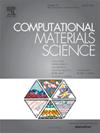Comprehensive evaluation of structural stability and optoelectronic performance of double perovskites Cs2AuMCl6 (M = Sb, Bi): Insights from theoretical perspectives
IF 3.1
3区 材料科学
Q2 MATERIALS SCIENCE, MULTIDISCIPLINARY
引用次数: 0
Abstract
Low-cost and high-performance lead-based halide perovskites have garnered intense interest, yet there are still two key issues like intrinsic instability and toxicity that need to be resolved. In this study, first-principles calculations are utilized to systematically evaluate the stability and optoelectronic properties of lead-free double perovskites Cs2AuMCl6 (M = Sb, Bi). Our calculations show that these two perovskites exhibit both thermodynamic and dynamic stability, suggesting their experimental synthesizability. Both compounds are characterized as indirect-gap semiconductors with fundamental gaps of 1.09 eV for Cs2AuSbCl6 and 1.58 eV for Cs2AuBiCl6. Further analysis reveals that they demonstrate favorable properties, such as low effective mass (0.18–0.32 m0) and small exciton binding energy (60–90 meV). Nevertheless, the significant mismatch between the optical absorption edge and fundamental gap in Cs2AuMCl6 (M = Sb, Bi) severely limits its solar absorption efficiency. Consequently, their maximum conversion efficiencies remain relatively low (15.60 % for Cs2AuSbCl6 and 7.75 % for Cs2AuBiCl6). Our comprehensive investigation of electronic structure and optical absorption uncovers the intrinsic mechanisms behind these efficiency limitations. This study provides valuable insights and guidance for the development of high-efficiency perovskite materials.

双钙钛矿Cs2AuMCl6 (M = Sb, Bi)结构稳定性和光电性能的综合评价:理论视角的见解
低成本和高性能的铅基卤化物钙钛矿引起了人们的强烈兴趣,但仍有两个关键问题需要解决,如内在不稳定性和毒性。在本研究中,利用第一性原理计算系统地评价了无铅双钙钛矿Cs2AuMCl6 (M = Sb, Bi)的稳定性和光电性能。我们的计算表明,这两种钙钛矿具有热力学和动力学稳定性,表明它们的实验合成能力。这两种化合物都是间接间隙半导体,Cs2AuSbCl6的基本间隙为1.09 eV, Cs2AuBiCl6的基本间隙为1.58 eV。进一步分析表明,它们具有较低的有效质量(0.18-0.32 m0)和较小的激子结合能(60-90 meV)等特性。然而,Cs2AuMCl6 (M = Sb, Bi)的光吸收边与基隙之间的明显不匹配严重限制了其对太阳的吸收效率。因此,它们的最大转换效率仍然相对较低(Cs2AuSbCl6为15.60%,Cs2AuBiCl6为7.75%)。我们对电子结构和光吸收的全面研究揭示了这些效率限制背后的内在机制。该研究为高效钙钛矿材料的开发提供了有价值的见解和指导。
本文章由计算机程序翻译,如有差异,请以英文原文为准。
求助全文
约1分钟内获得全文
求助全文
来源期刊

Computational Materials Science
工程技术-材料科学:综合
CiteScore
6.50
自引率
6.10%
发文量
665
审稿时长
26 days
期刊介绍:
The goal of Computational Materials Science is to report on results that provide new or unique insights into, or significantly expand our understanding of, the properties of materials or phenomena associated with their design, synthesis, processing, characterization, and utilization. To be relevant to the journal, the results should be applied or applicable to specific material systems that are discussed within the submission.
 求助内容:
求助内容: 应助结果提醒方式:
应助结果提醒方式:


